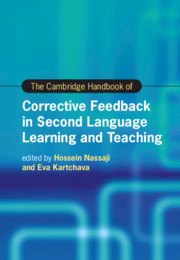Book contents
- The Cambridge Handbook of Corrective Feedback in Second Language Learning and Teaching
- Cambridge Handbooks in Language and Linguistics
- The Cambridge Handbook of Corrective Feedback in Second Language Learning and Teaching
- Copyright page
- Contents
- Figures
- Tables
- Contributors
- Acknowledgments
- Introduction Corrective Feedback in Second Language Teaching and Learning
- Part I Theoretical Perspectives on Corrective Feedback
- Part II Methodological Approaches in the Study of Corrective Feedback
- Part III Different Delivery Modes of Corrective Feedback
- Part IV Feedback Provider, Feedback Intensity, and Feedback Timing
- Part V Corrective Feedback and Language Skills
- Part VI Contexts of Corrective Feedback and Their Effects
- Part VII Learners’ and Teachers’ Feedback Perspectives, Perceptions, and Preferences
- Part VIII Individual Differences, Tasks, and Other Language- and Learner-Related Factors
- 30 Age and Corrective Feedback
- 31 Gender Effects
- 32 Feedback, Aptitude, and Multilingualism
- 33 Corrective Feedback and Affect
- 34 Corrective Feedback, Developmental Readiness, and Language Proficiency
- 35 Corrective Feedback and Grammatical Complexity: A Research Synthesis
- 36 The Role of Task in the Efficacy of Corrective Feedback
- Index
- References
36 - The Role of Task in the Efficacy of Corrective Feedback
from Part VIII - Individual Differences, Tasks, and Other Language- and Learner-Related Factors
Published online by Cambridge University Press: 26 February 2021
- The Cambridge Handbook of Corrective Feedback in Second Language Learning and Teaching
- Cambridge Handbooks in Language and Linguistics
- The Cambridge Handbook of Corrective Feedback in Second Language Learning and Teaching
- Copyright page
- Contents
- Figures
- Tables
- Contributors
- Acknowledgments
- Introduction Corrective Feedback in Second Language Teaching and Learning
- Part I Theoretical Perspectives on Corrective Feedback
- Part II Methodological Approaches in the Study of Corrective Feedback
- Part III Different Delivery Modes of Corrective Feedback
- Part IV Feedback Provider, Feedback Intensity, and Feedback Timing
- Part V Corrective Feedback and Language Skills
- Part VI Contexts of Corrective Feedback and Their Effects
- Part VII Learners’ and Teachers’ Feedback Perspectives, Perceptions, and Preferences
- Part VIII Individual Differences, Tasks, and Other Language- and Learner-Related Factors
- 30 Age and Corrective Feedback
- 31 Gender Effects
- 32 Feedback, Aptitude, and Multilingualism
- 33 Corrective Feedback and Affect
- 34 Corrective Feedback, Developmental Readiness, and Language Proficiency
- 35 Corrective Feedback and Grammatical Complexity: A Research Synthesis
- 36 The Role of Task in the Efficacy of Corrective Feedback
- Index
- References
Summary
This chapter identifies the paucity of overlap between the role of task in corrective feedback (CF) studies, and the role of CF in task-based studies. It goes on to argue, however, that classroom task design and implementation conditions can act effectively as facilitating conduits for CF without compromising the essentially implicit and incidental nature of task-based learning. The affordances of new pedagogies that use computer-mediated interaction are particularly useful in this regard, as are task implementation sequences in which CF is deployed at a post-task or pre-task stage.
Keywords
Information
- Type
- Chapter
- Information
- The Cambridge Handbook of Corrective Feedback in Second Language Learning and Teaching , pp. 777 - 795Publisher: Cambridge University PressPrint publication year: 2021
